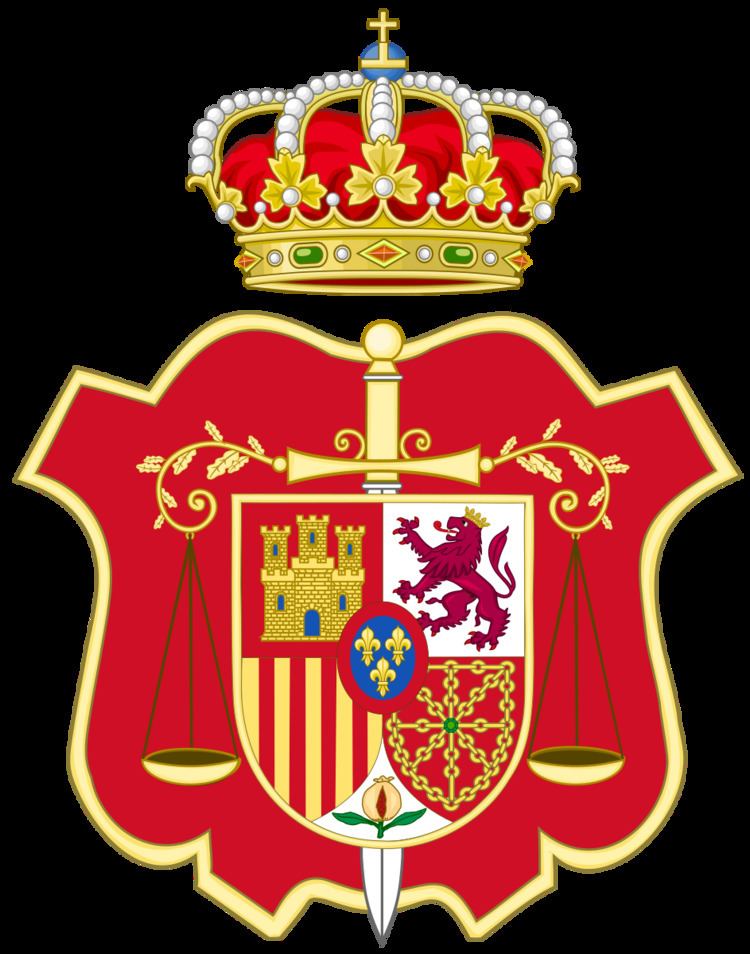Authorized by | Judge term length 5 years | |
 | ||
Established 1978; 39 years ago (1978) Composition method Members elected by the Congress and the Senate and appointed by the King. | ||
The General Council of the Judiciary (GCJ) (Spanish: Consejo General del Poder Judicial, CGPJ) is the constitutional body that governs all the Judiciary of Spain, such as courts, and judges, as it is established by the Spanish Constitution of 1978, article 122 and developed by the Organic Law 6/1985 of the Judicial Power (LOPJ). The President of the CGJP is also the president of the Supreme Court.
Contents
- Constitutional nature
- Functions
- Composition and manner of election
- According to the original wording of Article 112 of the Organic Law 61985 of July 1st of the Judiciary
- According to the modification made by Organic Law 22001 of June 21st
- Reform proposal of 2012
- Members of the GCJ
- Presidents
- Vicepresidents
- Members
- References
Constitutional nature
The Constitution of 1978 regulates the General Council of the Judiciary in paragrahps 2 and 3 of the section 122.
2. The General Council of the Judicial Power is its governing body. An organic act shall lay down its status and the system of incompatibilities applicable to its members and their functions, especially in connection with appointments, promotions, inspection and the disciplinary system.
3. The General Council of the Judicial Power shall consist of the President of the Supreme Court, who shall preside it, and of twenty members appointed by the King for a five-year period, of which twelve shall be judges and magistrates of all judicial categories, under the terms provided for by the organic act; four nominated by the Congress and four by the Senate, elected in both cases by three-fifths of their members amongst lawyers and other jurists of acknowledged competence with more than fifteen years of professional practice.
This means that, the Constitution only detail the way of election of the eight members of the GCJ that they will be chosen between the most renowned jurists. It requires a minimum of 15 years of experience. Four of them must to be chosen by the Congress and the other four by the Senate. Both case requires a majority of three fourths of the members of every Chamber to be elected member of the GCJ.
Otherwise, for the election of the twelve members precedents of the judiciary, with independence of the professional category that they belong (Magistrate of the Supreme Court, Magistrate or Judge), the Constitution refers to what is established in a future Organic Law. The Cortes fulfilled this constitutional mandate with the approval of the Organic Law 6/1985, of 1 July, of the Judicial Power.
Functions
The GCJP is not a jurisdictional body, but an overseeing and organising body of the Spanish Judiciary - it does not form part of the judiciary itself. Among its main functions are:
The GCJP is also compelled to report on all the laws and legal dispositions of the State and the Autonomous Communities pertaining to judicial questions, as well as being consulted in the naming of the Attorney General of the State.
Composition and manner of election
The Constitution determines in its article 122.3:
The Organic Law 2/2001 (currently in force), modified the Organic Law 6/1985 in which refers to the election system:
Of the 12 members who must be Judges or Magistrates, 6 are elected by Congress and 6 by the Senate, from a list of 36 candidates proposed by associations of judges or by non-associate judges.
According to the original wording of Article 112 of the Organic Law 6/1985, of July 1st, of the Judiciary
Each of the chambers that form the Cortes Generales chose ten members by a qualified majority of three fifths. Six among active duty judges and four among lawyers of recognized competence. Members of the outgoing Council or those who provided services in their technical bodies could not be elected.
The President is appointed by the Plenary of the GCJ between members of the judicial career or jurists of recognized competence. During his term, members can not be removed, replaced, or terminated and can not be re-elected. Formally, they are appointed by the King of Spain.
According to the modification made by Organic Law 2/2001 of June 21st
Organic Law 2/2001, of June 21, modified article 122 of the Organic Law of the Judiciary reforming the election method between members comming from the judiciary. The professional associations of the judiciary or groups of judges who make up at least 2% of the total on active duty may present to the chambers a total of thirty-six candidates, of which the Congress shall elect six And the other six will be chosen by the Senate from among the remaining thirty.
Reform proposal of 2012
Alberto Ruiz-Gallardón, minister of Justice, announced in 2012 his intention to change the method of election of the 12 members of the GCJ, returning to the old system of 1985. However, on December 21, 2012 the minister attended to the Council of Ministers with a preliminary project in which it was established that the election of the twenty members of the governing body of the judges was carried out directly by the Parliament, without previous elections in the judicial career. Ruiz-Gallardón considered that the reform, consensual with the PSOE, would contribute to depoliticization justice. The Council of Ministers rejected this project.
Members of the GCJ
The members of the General Council of the Judiciary are the President, the Vicepresident and the Members.
Presidents
The President of the GCJ is also the President of the Supreme Court. They are:
Vicepresidents
Members
This are the current Members of the GCJ since November 29, 2013. They were elected by the Congress and the Senate:
